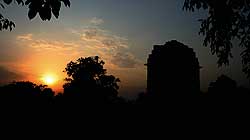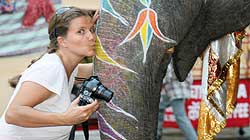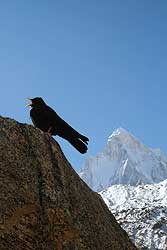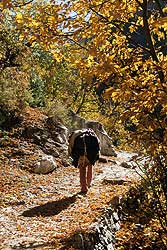|
Clicking Integrity

Bed time India Gate, Delhi
These days, taking good photographs is not such a big deal, or so it seems…
-By: Susan M. Griffith-Jones
Most people carry digital cameras that range from fairly good to extremely high-resolution capacities and almost all of us have a mobile phone that will do the job just as well. But do we ever stop to consider what it is that time and time again forces us to click a scene laid before our eyes. Are we really in touch with the deeper process ensuing?
Are we aware that we are snapping a moment of existence that will never appear in that exact, precise way ever again? Are we aware that we are the unique observer of a scene that lies before us? Are we aware of the affect it is having on ourselves, as individuals?
 Just the idea of taking photographs forces us to notice things. If we are snapping an individual, we want a pretty background to frame him or her, so our eyes begin to check the scene for just such a backdrop. If we are in a busy place, then we search out interesting events to capture, or if we are in a beautiful place and wish to just embrace the scenery, then we angle out the space to get the whole picture in. On a recent trip to Jaipur, I found myself in its notorious bazaar of The Pink City, where the colours, sounds and merchandise are dazzling to the eyes, not to mention those whose are selling their wares. I am not a shopper, so I was not out to bargain and buy, but the scene was of such intensity that somehow I wished to capture precisely that mood, in the still, frozen instant of the picture. Just the idea of taking photographs forces us to notice things. If we are snapping an individual, we want a pretty background to frame him or her, so our eyes begin to check the scene for just such a backdrop. If we are in a busy place, then we search out interesting events to capture, or if we are in a beautiful place and wish to just embrace the scenery, then we angle out the space to get the whole picture in. On a recent trip to Jaipur, I found myself in its notorious bazaar of The Pink City, where the colours, sounds and merchandise are dazzling to the eyes, not to mention those whose are selling their wares. I am not a shopper, so I was not out to bargain and buy, but the scene was of such intensity that somehow I wished to capture precisely that mood, in the still, frozen instant of the picture.
That is a task easily accomplished by a video camera, where you have the tools of sound and movement to aid the feeling, but how does one do this in a still picture? Is it not the face of the person, or faces (if it is many), of those within the scene that will tell the entire story. They are the mood, they are the feelings and they are encompassing whatever is present in their surroundings. Take them out and an entirely new picture appears.
 Then there is the moral issue of taking photos of people without changing their mood from a true and natural sense into one of stiff self-consciousness. Do you photograph them unknowingly so as to retain the mood, essentially reducing the photographer to the state of thieving or do you first ask their permission and then hope that it doesn’t change the entire impression? Then there is the moral issue of taking photos of people without changing their mood from a true and natural sense into one of stiff self-consciousness. Do you photograph them unknowingly so as to retain the mood, essentially reducing the photographer to the state of thieving or do you first ask their permission and then hope that it doesn’t change the entire impression?
So does one enter their chosen world, ducking and diving a way through the place, capturing the moods and expressions of its inmates, whilst themselves becoming intimately attached to the various occurrences and details that are going on there.
The same goes for wide-open scenes too. On a recent trip to Gaumukh, source of the River Ganges, I trekked the last twenty-something kilometres from the small town of Gangotri to the end of the glacier, where the river trickles out as both lumps of ice and freezing cold melt stream water.
It was autumn and the scene was magical everywhere you looked. I caught the shape of trees, water dripping over rocks, the path ahead, the path behind, the tips of mountains and the ribbon-like snaking of the river starting its infant course towards the plains of North India.
I was not just walking to Gaumukh, I had become part of that place, its details and different moods of the day. Dark at the stage of dawn before sunrise and then following the shadows of the day playing with the contours of the mountains, crossing from light into dark as the sun coursed its natural path across the sky, (or rather as the Earth coursed its natural way around the sun), I captured the same vision brushed with different paint strokes.
 As I transitioned - reluctantly so at first - into the world of digital photography, it seemed to me that its “art” had faded and that we had all suddenly become budding amateur photographers allowing the camera to do most of the work, while we could enjoy the precise result of its self-programming. Was there any need for professional photography anymore, I wondered? As I transitioned - reluctantly so at first - into the world of digital photography, it seemed to me that its “art” had faded and that we had all suddenly become budding amateur photographers allowing the camera to do most of the work, while we could enjoy the precise result of its self-programming. Was there any need for professional photography anymore, I wondered?
Seemingly undermining digital photography in this way, I finally came to understand it as actually far more technical than earlier cameras as there are generally more buttons and settings than before, which means you need to know more than before, not to mention the programme that you download them onto on your computer, where you can brighten, darken, add and subtract colour, crop, paste etc…
Having been trained with my old, 1970 something, top-of-its-range at the time, Pentax, whose light meter had long gone to pot, it anyhow took some removal of stubbornness before I embraced the new phenomena as an incredible artistic tool.
The results were astounding, not just in quality of picture, but on the effect it produced with my relationship with subjects and scenes that I was photographing.
I discovered a mind unclouded by the technical aspects of aperture and shutter speeds that need to be set at lightening speed on the old analogue cameras and thereby freed to explore another aspect of this art. I found myself more concentrated on the main focus of the picture as well as its frame to complete the contextual meaning as well as the range of photos taken during a period of being in a certain place.
Knowingly, or even unknowingly, one can easily dissect places into precise sections, like a kind of photographic journal. Citing an example of this, I have noticed that during the years of living in India and coming again and again to its capital for various reasons, Delhi has became parks, people, animals and monuments for me, thus divided into sub-sections of flowers, trees, birds, Mughal history, British, post-colonial etc…
From this, I have also been able to assess my sense of priorities when I travel to places in general, for I have now noticed that these divisions are fairly constant in most destinations of my travels, even though their sub-divisions arise according to their personal histories and cultural facets. What causes me to sub-consciously snap various aspects of places and its people?
One would perhaps not notice such things without the camera, the bridge that may take you into another world, your world in fact that is laid right there before your eyes, where you see and feel the mood, searching it and encompassing it the more you delve into your subject.
So too am I learning about myself with the subtle guidance of the camera, an eye to a world that I may not have viewed if I did not have its curious wisdom and compassionate gaze to see with.
—Author, Susan M. Griffith-Jones lives in the secluded forests surrounding the old British hill-station of Mussoorie, in the foothills of the Indian Himalayas. Writer of two published books as well as an artistic documentary filmmaker, her interest in photographs has developed over the years, culminating in photographic exhibitions ranging different subject matters. Her website, www.pyramidkey.com has a comprehensive photo gallery of her work.
|